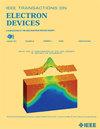Enhanced Dye-Sensitized Solar Cells via MoS2 Nanosheets-Modified TiO2 Photoanodes
IF 3.2
2区 工程技术
Q2 ENGINEERING, ELECTRICAL & ELECTRONIC
引用次数: 0
Abstract
Molybdenum disulfide (MoS2), is a novel 2-D material, has recently garnered significant attention. In this study, MoS2 nanosheets (NSs) were synthesized via a liquid-phase exfoliation (LPE) method, and subsequently used to modify the titanium dioxide (TiO2) photoanode of dye-sensitized solar cells (DSSCs). The incorporation of MoS2 NSs not only enhances dye adsorption due to their high specific surface area but also reduces the carrier recombination rate attributed to their excellent carrier mobility. These combined effects contribute to an improvement in the photovoltaic conversion efficiency (PCE) of DSSCs. Notably, the efficiency of DSSCs with MoS2 modification increased from 4.99% to 6.55%, representing a 31% improvement.MoS2纳米片修饰TiO2光阳极增强染料敏化太阳能电池
二硫化钼(MoS2)是一种新型的二维材料,近年来引起了人们的广泛关注。本研究采用液相剥离法(LPE)合成了MoS2纳米片(NSs),并将其用于修饰染料敏化太阳能电池(DSSCs)的二氧化钛(TiO2)光阳极。MoS2 NSs的加入不仅由于其高比表面积而增强了染料吸附,而且由于其优异的载流子迁移率而降低了载流子重组率。这些综合效应有助于提高DSSCs的光伏转换效率(PCE)。值得注意的是,经过MoS2修饰的DSSCs的效率从4.99%提高到6.55%,提高了31%。
本文章由计算机程序翻译,如有差异,请以英文原文为准。
求助全文
约1分钟内获得全文
求助全文
来源期刊

IEEE Transactions on Electron Devices
工程技术-工程:电子与电气
CiteScore
5.80
自引率
16.10%
发文量
937
审稿时长
3.8 months
期刊介绍:
IEEE Transactions on Electron Devices publishes original and significant contributions relating to the theory, modeling, design, performance and reliability of electron and ion integrated circuit devices and interconnects, involving insulators, metals, organic materials, micro-plasmas, semiconductors, quantum-effect structures, vacuum devices, and emerging materials with applications in bioelectronics, biomedical electronics, computation, communications, displays, microelectromechanics, imaging, micro-actuators, nanoelectronics, optoelectronics, photovoltaics, power ICs and micro-sensors. Tutorial and review papers on these subjects are also published and occasional special issues appear to present a collection of papers which treat particular areas in more depth and breadth.
 求助内容:
求助内容: 应助结果提醒方式:
应助结果提醒方式:


